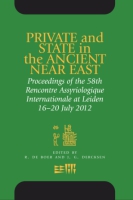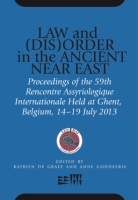As Above, So Below
Religion and Geography
Edited by Gina Konstantopoulos and Shana Zaia
This volume addresses the nexus of religion and geography in the ancient Near East through case studies of various time periods and regions. Using Sumerian, Akkadian, and Aramaic text corpora, iconography, and archaeological evidence, the contributors illuminate the diverse phenomena that occur when religion is viewed through the lenses of space and place. Gina Konstantopoulos draws upon Sumerian literature to understand mythicized and semimythicized locations. Seth Richardson and Elizabeth Knott focus on the Old Babylonian period, with Richardson addressing the interplay between law, location, and the gods, while Knott turns from text to image, relocating the reader to Syria and realizing the potential of royal iconography when situated in the “right” space. Shana Zaia moves forward to the first millennium, following the capital of the Neo-Assyrian Empire as it shifted from city to city, with divine implications. Finally, Arnulf Hausleiter and Sebastiano Lora focus on northwest Arabia, unearthing a local pantheon and situating it among the various influences in the region from the second millennium onward.
- Description
- Bio
- Table of Contents
- Sample Chapters
Covering a broad geographical and temporal scope while maintaining a cohesive focus on the theme, this book will appeal especially to Assyriologists, scholars of the ancient Near East, and specialists in historical geography.
Gina Konstantopoulos is Assistant Professor in Assyriology and Cuneiform Studies at the University of California, Los Angeles.
Shana Zaia is Marie Skłodowska-Curie Fellow in the Department of Near Eastern Studies at the University of Vienna.
List of Abbreviations
Editor’s Introduction
Gina Konstantopoulos and Shana Zaia
Chapter 1. Gods in the Margins: Religion, Kinship, and the Fictionalized Frontier
Gina Konstantopoulos
Chapter 2. Place and Portability: Divine Emblems in Old Babylonian Law
Seth Richardson
Chapter 3. Mari’s Investiture Scene and the Visualization of Kingship in the Old Babylonian Period
Elizabeth Knott
Chapter 4. Divine Foundations: Religion and Assyrian Capital Cities
Shana Zaia
Chapter 5. Approaches to the Religious Topography of the Oasis of Taymāʾ, Northwest Arabia, During the First Millennium BCE: Images, Texts, and Space
Arnulf Hausleiter and Sebastiano Lora
List of Contributors
Download a PDF sample chapter here: Chapter One
Mailing List
Subscribe to our mailing list and be notified about new titles, journals and catalogs.









